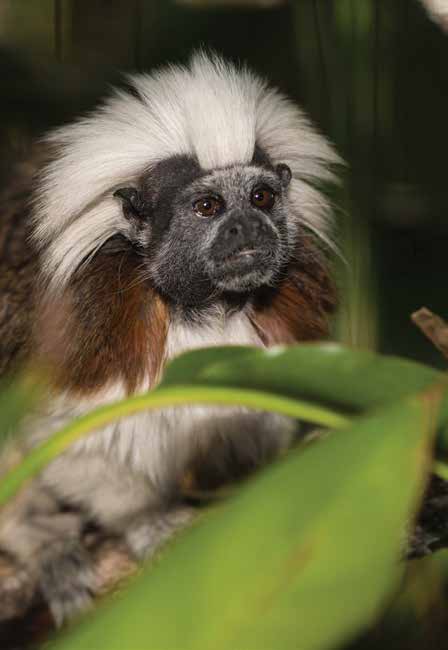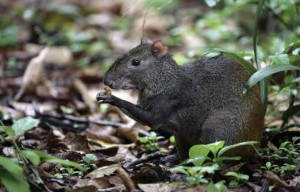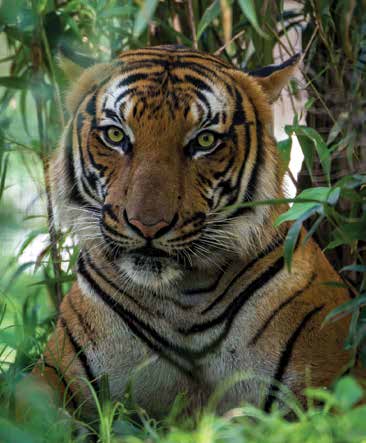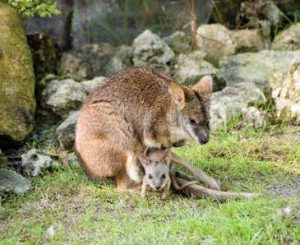Lions, Tigers, Bears
Sure, but how about Muntjac, Agoutis, and Tamarins?
by Tim L. Tetzlaff
Director of Conservation & Communications | Naples Zoo at Caribbean Gardens
Ever since author Frank L. Baum had Dorothy gasp “Lions and tigers, and bears, oh my!” on her journey along the yellow brick road, these iconic animals have become inseparably linked and anticipated favorites on a zoo visit. As part of our mission to delight guests, we enjoy sharing both familiar animals like these as well as inspiring wonder and appreciation for the natural world by introducing families to unusual creatures that even today are largely unknown – including some almost as amazing as flying monkeys.
“It’s still an age of discovery,” explains Naples Zoo President and CEO Jack Mulvena. “Not only are scientists still finding new species, but also revealing the secret lives of animals that science has known about for centuries.” While many of these are documented in scientific journals, they often do not reach the general public except in venues like zoos. “Sharing these wonders of the animal kingdom is part of our education mission at the daily shows, cruises, and keeper talks, as well as other venues from evening lectures to the website and social media,” explains Mulvena.
Even some familiar types of animals have hidden surprises. The Reeve’s muntjac deer and the red-footed tortoise stray from their expected vegetarian diet and will eat the carcasses of other animals. And while everyone knows marsupials and their pouches, few people know they have the remarkable ability to delay a pregnancy. So if a drought or other food shortage occurs, marsupials like the Zoo’s Parma wallabies have the ability to hold the baby in a state called embryonic diapause until conditions improve.
Others have fascinating adaptations that help them or their ecosystem. The small desert-dwelling slender-horned gazelles have modified nasal passages that enable them to cool their blood. And only the gnawing teeth of agoutis can open the Brazil-nut trees’ tough fruit pods. These large rodents eat some of the dozen or more nuts inside the pod and bury the rest. Their imperfect memory of their hiding places lets new trees sprout and enables the Amazon to keep one of its most important plants.
But there’s far more than these familiar and unusual considerations determining which animals you’ll find in the zoo. “Here in Naples, criteria for the collection plan include baseline factors like climate as an obvious example,” explains Director of Animal Programs Liz Harmon. “So we won’t be bringing in polar bears.” But it is an ideal environment for many tropical animals like the critically endangered cotton-top tamarins. These small monkeys sport a shock of white hair worthy of any punk rocker and have the teenager-like habit of sleeping in. Far from lazy, it’s actually a strategy to avoid predators that are active around sunrise.
Other issues include the conservation status of a species in the wild. Harmon continues, “So the tigers you see here are not just any cats, but purebred Malayan tigers that were only identified as a distinct subspecies in 2004. Their wild population has been nearly cut in half recently and is only estimated between 250 and 340 individuals. Thus it’s critical to have these endangered species in protective custody.”
For perspective, the Indonesian government tried to save the Javan tiger in the wild without a secure population in zoos. Putting all the eggs in that basket proved tragic when the last Javan tiger on the planet died during the last part of the twentieth century. Harmon shares, “Concerted efforts through the Species Survival Plan® for Malayan tigers are insuring a brighter future for these majestic cats.”
For other species, the importance for education is paramount. Thus, Zoo visitors can learn how to best live with the more than one million alligators we share the state with as well as the growing number of black bears making their way into more and more neighborhoods. And through the lecture series, we can bring rare species to light like South America’s Giant Armadillo that are not in any zoo.
The foundation for this diverse array of animals that call our garden their home as well as the conservation projects we support in the wild is our national accreditation by the Association of Zoos and Aquariums (AZA). Less than one in ten of the federally licensed wildlife exhibitors have met these strict standards. Because of this, Naples Zoo is entrusted with the care of some of the planet’s rarest creatures.
Far from the simple menageries of past, today’s accredited zoos are centers of learning and natural crossroads for biologists, educators, environmental scientists, and researchers – as well as for students, conservationists, and all animal lovers. Your visit, membership, or donation allows us to continue sharing these wonders and promoting that appreciation for nature to realize that better future for people and
wildlife we all hope to see.
Naples Zoo at Caribbean Gardens is a trusted, private 501(c)(3) nonprofit serving wildlife and families here and around the world. Collier County designated it an official Historic Site and the garden is accredited by The Morton Register of Arboreta. Naples Zoo also earned national accreditation by the Association of Zoos and Aquariums, which sets the world’s highest standards for wildlife care. More information at www.napleszoo.org.





Leave a Reply
Want to join the discussion?Feel free to contribute!